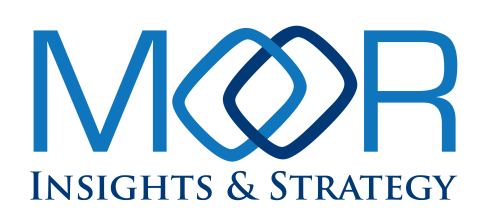
The Moor Insights & Strategy team hopes you had a nice Labor Day weekend! 🇺🇲
Last week, Patrick Moorhead, Will Townsend, and Matt Kimball attended VMware Explore 2024. Matt also attended the GlobalFoundries Analyst event. Robert Kramer was in New York for the IBM SAP Analyst and Advisory Services Day, and Robert and Melody Brue were at the US Open with IBM.
This week, Anshel Sag is at IFA Berlin. Next week, Patrick, Melody, Matt, and Robert will be in Las Vegas for Oracle Cloud World, and Will Townsend will be in London for Connected Britain, where he’s also moderating a panel. Jason Andersen will be in Austin for JFrog swampUP 24.
Our MI&S team published 16 deliverables:
- 7 Forbes Articles
- 1 MI&S Research Note
- 3 MI&S Blog Posts
- 5 Podcasts
Over the last week, our analysts have been quoted numerous times in international publications with our thoughts on NVIDIA earnings, IBM, Crowdstrike, Amazon, and AI-powered smart glasses.
Patrick Moorhead appeared on CNBC Closing Bell Overtime to discuss CrowdStrike’s stock spike after its first quarterly report since the global outage and again to discuss NVIDIA’s Q2 2025 earnings. Patrick was also on Yahoo! Finance to discuss NVIDIA earnings. You can also check out this supercut of Patrick discussing NVIDIA’s competition on Yahoo! Finance.
MI&S Quick Insights
I’ve speculated about OpenAI’s Strawberry release several times over the past few weeks, here and elsewhere. Most of my coverage is based on research papers and factual material, so it’s fun to occasionally go off the factual rails and speculate. Most recently another story appeared in The Information reporting that Strawberry was demonstrated to the U.S. government. The old information is that Strawberry will have much greater reasoning power than what’s available today. The newer information is that OpenAI is working on a new LLM called Orion, and Strawberry will be used to train and enhance Orion. Whenever it is released, I believe it will move us into a new era of AI, one of super-reasoning. I’m looking forward to something that will be unique.
iAsk.AI is a relatively new entity to me, but I think I’ve found a new go-to AI model. iAsk.AI is a cutting-edge AI search engine developed by a new company called AI Search Inc., which was established last year. Its founders previously created CamFind, a visual search engine, and JRank, a search tool for searching a single complex website. iAsk.AI uses that technology to deliver instant responses for user queries.
iAsk Pro was the first model to achieve the first “Expert AGI” performance, scoring 93.89% on the MMLU benchmark and 85.85% on the new MMLU Pro test. The MMLU (Massive Multitask Language Understanding) benchmark evaluates the performance of AI models across a wide range of subjects, including science, mathematics, history, and more. It comprises over 12,000 questions from academic exams and textbooks, testing an AI’s understanding and reasoning abilities in diverse domains. The new MMLU Pro test is an updated and more difficult version of this benchmark. Achieving an 85.85% score on MMLU Pro indicates that the AI model performs exceptionally well and surpasses the accuracy of many human experts in these subjects. It outperformed the previous best model, GPT-4, by a large margin of 12 percentage points.
I’ve speculated about OpenAI’s Strawberry release several times over the past few weeks, here and elsewhere. Most of my coverage is based on research papers and factual material, so it’s fun to occasionally go off the factual rails and speculate. Most recently another story appeared in The Information reporting that Strawberry was demonstrated to the U.S. government. The old information is that Strawberry will have much greater reasoning power than what’s available today. The newer information is that OpenAI is working on a new LLM called Orion, and Strawberry will be used to train and enhance Orion. Whenever it is released, I believe it will move us into a new era of AI, one of super-reasoning. I’m looking forward to something that will be unique.
iAsk.AI is a relatively new entity to me, but I think I’ve found a new go-to AI model. iAsk.AI is a cutting-edge AI search engine developed by a new company called AI Search Inc., which was established last year. Its founders previously created CamFind, a visual search engine, and JRank, a search tool for searching a single complex website. iAsk.AI uses that technology to deliver instant responses for user queries.
iAsk Pro was the first model to achieve the first “Expert AGI” performance, scoring 93.89% on the MMLU benchmark and 85.85% on the new MMLU Pro test. The MMLU (Massive Multitask Language Understanding) benchmark evaluates the performance of AI models across a wide range of subjects, including science, mathematics, history, and more. It comprises over 12,000 questions from academic exams and textbooks, testing an AI’s understanding and reasoning abilities in diverse domains. The new MMLU Pro test is an updated and more difficult version of this benchmark. Achieving an 85.85% score on MMLU Pro indicates that the AI model performs exceptionally well and surpasses the accuracy of many human experts in these subjects. It outperformed the previous best model, GPT-4, by a large margin of 12 percentage points.
VMWare Exchange was a big event for the IT Automation crowd this week, and the big news was the effort to simplify what had previously been a complex lattice of products. VMWare Cloud Foundation 9 is now a solid and more unified starting point for customers to build their own clouds. Much of the coverage has been on the unification of compute, storage, and networking features, but there are also new DevOps services that are notable. The consolidation of multiple ops services and stakeholders are trends that I discussed in this article published just a few days ago. A few years ago, we all would have been surprised to see VMware include a native Kubernetes stack within its foundation offering, but it’s there in VCF 9. Between these base DevOps services and a rich set of add-on capabilities, it will be very interesting to see how Broadcom will continue to build bridges to developer ecosystems.
This week I also had the pleasure to speak with two startups that are specifically working on how AI can improve the productivity of development teams. This is a big step forward from the personal productivity benefits associated with AI assistants embedded in an IDE. Network Perspective is a Polish firm that collects and aggregates team data from collaboration and productivity apps to figure out how development teams can work better together, with the goal of making more time for the deep work that developers need to get into the flow. Network Perspective is already helping customers and is showing a new use for AI. The second startup is still in stealth mode, but the idea is to create a new type of IDE that allows developers to work on the same sets of code at the same time, with an AI assistant facilitating the process. Think of it like a virtual hackathon. These two new approaches to innovating are starting to show us all that there is more to AI than chatbots. I’ll be keeping an eye on these startups as they navigate the market.
Investors are worried about how Salesforce’s use of AI agents could affect productivity and the need for customer license seats. During a Q&A session for its Q2 2025 earnings call, CEO Marc Benioff said that there is significant interest in AI agents, with approximately 200 million currently in trials. Salesforce is considering a new consumption-based pricing model, which could involve charging $2 per AI agent conversation. The company is confident in its AI strategy, especially with the upcoming launch of the Einstein 1 Agentforce Platform. Salesforce’s goal is to have one billion AI agents in use by the end of fiscal year 2026.
VMware Explore 2024 came and went, and the big news out of this event was VCF 9. This launch is the beginning of the company’s strategy coming into focus as it looks to effectively deliver the public cloud on-prem. Billed as a private cloud solution, VCF 9 is, to me, the realization of what enterprise IT craves—a wholly crafted cloud stack and operating model that also allows an IT executive to deliver the environment and agility that their developers and data scientists require while simplifying the way their IT staff deploys, provisions, and manages infrastructure.
As I said, I think VCF 9 is what IT craves, but I’m not sure that IT realizes they crave this. This is due largely to perception—especially the perception issue around the term “private cloud.” This is a phrase that is tied to older technologies that never quite met the expectations of enterprise IT organizations and eventually gave way to hybrid cloud technologies. I would have greatly preferred the company find a different way to position VCF other than “private cloud.” Or at least to refer to it as a later version—an evolution of the older private cloud.
One thing I didn’t hear addressed at the event is how VCF supports hybrid cloud. To tell enterprise IT organizations that they simply need to repatriate all of their apps and data from the public cloud back to on-prem is not realistic. And the company has not really demonstrated how it will resolve this.
That said, I do like how the company has laid out a vision for VCF, along with a set of tools and services to enable this transformation. I also like how the company has laid down a strong opinion on what the future datacenter looks like. Now it just needs to execute against this vision.
How about that Nutanix quarter?! The company showed a strong beat on expectations and its guidance was even stronger. Nutanix has executed a strong strategy—a masterclass in leveraging market disruption (in this case caused by VMware turbulence). How did it do so? By activating OEM and channel partnerships, from both a technical and go-to-market perspective.
Pure Storage delivered a strong second quarter, outpacing the market in terms of growth. Despite this, the company saw its stock take a significant drop as its guidance for the rest of year fell short of expectations. While I understand that the Street is forward-looking, it is disappointing to see a company punished while delivering stellar results and forecasting growth for the future. Regardless, it is good to see Pure establishing a stronger presence in both AI and hyperscalers, markets that represent the largest growth vectors in the storage market.
Are these Dell Technologies quarterly numbers real??? The company’s Infrastructure Solutions Group (ISG) saw a 38% year-over-year increase in revenue (to $11.6 billion) and a 22% YoY increase in operating income (to $1.2 billion). Both traditional and AI server sales saw strong growth and significant pipelines. Interestingly, the company’s storage business struggled, shrinking 5% YoY in terms of revenue. This is a continuing trend for the company that has seen its storage business on a continual decline, despite what it says is increased demand for core storage.
What is going on? I believe that AI and the performance requirements associated with it have put a renewed focus on high-performance storage. And while Dell’s storage portfolio is more than adequate, many storage companies (such as Pure, VAST, and Weka) are positioning themselves as critical to feeding the AI data pipeline.
No doubt Dell will find its footing on the storage front. And its >$7 billion revenue in servers and networking looks like it will be eclipsed next quarter.
MLPerf Inference 4.1 benchmark results were published this week, and there were some interesting numbers in the release. While NVIDIA ruled (as one would expect), AMD showed some compelling results with its first submission to the benchmark. Meanwhile, Untether AI demonstrated performance-per-watt leadership with its SpeedAI 240 accelerator.
While the AI training market is a battle among a few companies—and dominated by one—AI inference is an entirely different game. Traditional GPUs and big silicon will be challenged by companies like Untether AI that have designed and developed highly performant silicon that fits into very small power envelopes to support the diversity of use cases that span the enterprise.
Keep an eye on Untether AI and other companies like it (such as Tenstorrent)—this inference game is just heating up.
IBM and the US Open made last week memorable for me. It started with meeting Tracy Austin and her offering advice on my backhand for tennis and pickleball. When I was growing up I watched her win the US Open as a teenager (twice!); it was fantastic to hear her thoughts on IBM’s technology. FYI, she said she uses a two-handed backhand in pickleball (interesting!).
IBM is clearly transforming the way we experience sports and entertainment. This can be appreciated when we realize that IBM has been collecting data for the past 30 years in partnership with the United States Tennis Association for the US Open—in parallel with its efforts at Wimbledon and The Masters. I had the chance to use the US Open mobile app firsthand when I attended a few matches. The app provided detailed stories, scores, stats, AI-driven predictions, news, schedules, and much more that added a new layer of depth to the tournament experience. What really impressed me was its integration with Ticketmaster, which lets you access your tickets for the matches right within the app.
IBM’s technology from the US Open is making its way into various industries beyond sports and entertainment. In retail, it can be used to create personalized shopping experiences. In healthcare, it can enhance patient care. The cybersecurity measures deployed at the US Open can help financial institutions protect sensitive data. AI and data analytics can be used to optimize production processes in manufacturing, and these innovations are extending to many other sectors as well.
Much of the buzz around GenAI is centered on the compute side of the infrastructure stack. However, networking is a crucial component, serving as the conduit to move data, connect large language models, and eventually extend workloads to the network edge. Although Dell Technologies posted healthy growth in AI server sales in its recent quarterly earnings, its networking strategy heavily relies on Broadcom. That might not be a bad thing, given Broadcom’s investment in extending Ethernet’s interconnect capabilities, but companies such as HPE that are doubling down on networking infrastructure beyond using merchant silicon could gain an edge in delivering a more complete GenAI solution.
Last week the SAP practice within IBM Consulting hosted me for its analyst strategic session while I was in New York for the US Open. It was a valuable experience to join the IBM SAP team and discuss the critical nature of ERP systems for global enterprises. During the session, we discussed the key elements that contribute to successful ERP transformations and why the IBM SAP team has been effective. It starts with a global network of 18,000 certified SAP professionals. Solid execution processes, including change management, are also critical. Strong data management is at the core of this success, particularly given that AI is used to support project delivery and application management across industries including manufacturing, consumer goods, retail, defense, automotive, and utilities. In the coming weeks I’ll be writing up my research detailing more specifics, including case studies, on IBM SAP.
Transportation management systems (TMS) are improving supply chains by making operations more efficient for manufacturers, distributors, e-commerce businesses, retailers, and third-party logistics providers. These systems help streamline shipping, lower costs, improve profitability, and offer better visibility into the supply chain—in short, automating complex processes to secure transportation services at the best possible price without sacrificing quality. The value of TMS comes from understanding how to use the technology effectively and managing its implementation carefully to achieve tangible business results. TMS solutions can be part of larger SCM and ERP systems or used on their own. As TMS usage increases, I’ll explore their challenges, benefits, and impacts on businesses. More details to come.
According to Paycor’s “HR in 2025” study, newer employees are particularly prone to turnover, and remote workers often express less favorable views of their leaders and experience role ambiguity. Paycor surveyed more than 7,000 HR, finance, and IT professionals for the report. Some interesting key takeaways: The ongoing talent shortage is due to several factors, including low birth rates, retirements, skills gaps, and caregiving obligations.
In addition, the employee experience needs to start at the application step. 52% of candidates have declined job offers due to a poor experience during the hiring process, according to CareerPlug. To navigate this, companies are increasingly turning to AI to optimize their recruitment process and improve the candidate experience. This includes a wide gamut of processes, including broadening the candidate pool beyond active job-seekers, and automating touchpoints that keep applicants updated and feeling valued, even when they don’t end up with an offer.
In a recent analyst briefing, Ericsson provided details about “site energy orchestration,” an initiative to reduce cellular infrastructure energy costs. The company says global mobile networks comprise 1% of global energy consumption (source: GSMA report 2024), so savings could be significant. Electric utilities are rapidly moving to dynamic pricing models that reflect real-time supply and demand. Ericsson shaves loads to avoid peak prices, charges local batteries when rates are low, switches to battery power when rates are high, and sells excess power back to the grid from on-site renewables and batteries. Ericsson’s field tests produced savings of 36% when combining these features. Any home or business, not just cell sites, can reap these benefits by orchestrating electricity flow, and that’s where IoT comes in. Matter, the smart home connectivity standard from Amazon, Apple, Google, Samsung, and other companies, enables the whole-home device communication required to manage electricity usage, storage, and generation. This paper explains how autonomous energy orchestration software using Matter-connected equipment can deliver measurable financial benefits. As more homes and businesses orchestrate power usage, the effects become grid-scale, with public policy implications. Bravo Ericsson!
I’m increasing my coverage of the Linux Foundation’s LF Edge project to include two new at-large projects that are consistent with my views on IoT middleware and device software evolution. The first one is EdgeLake, sponsored by AnyLog—a distributed, virtual relational database that combines structured data from multiple sites. A standard SQL query selects results from all databases, regardless of location. There are two big advantages to this approach: (1) Only actionable data travels over the network. All data stays local, at the edge, until a specific query calls for it. (2) EdgeLake is pure middleware with standard SQL interfaces and no system dependencies. So, it can plug and play with any device and any back-end application. The second project is Ocre, sponsored by Atym, which uses WebAssembly (Wasm) and Zephyr to provide ultra-lightweight containers for microcontroller-based edge devices, enabling developers to focus on applications without building custom OSes, system images, and OTA update services. It’s like Docker for small devices. Both projects are worth watching.
In addition to the two LF Edge projects described above, the Linux Foundation’s Joint Development Foundation is sponsoring Margo, a mechanism for orchestrating applications and workloads on edge devices. Margo’s goals are ambitious (perhaps too ambitious), but big companies are involved (Microsoft, Intel, ABB, Capgemini, Rockwell, Schneider, Siemens, and more), so the initiative has plenty of resources. Margo is also worth watching.
Apple’s upcoming iPhone launch is happening on September 9 at 10 a.m. Pacific, and I believe it will be very iPhone- and AI-heavy. We might get more updates on wearables, though I don’t think we’ll get Macs running Apple’s M4 chips at the same event.
Anandtech’s abrupt shutdown marks the end of a 27-year journey for the hardware review publication, which will be missed by many and will leave a mark on the industry for many years to come.
A panel of justices from Brazil’s Supreme Court has upheld an order that X (formerly Twitter) be banned in that country. This ruling—the latest twist in months of conflict between the Brazilian judiciary and X over allegations of disinformation—shows the challenges of running a social media platform at global scale without global uniformity of law.
Spotify is (understandably) upset that Apple has stopped the function that allows the volume buttons on iPhones to work for Spotify Connect, forcing Spotify users to resort to a workaround to control this basic feature on connected devices such as wireless speakers or smart TVs. Spotify holds that this violates the Digital Markets Act in the EU, and I believe Apple’s actions will just set off another round of lawsuits in Europe—where Apple has already run into much resistance.
Post-quantum cryptography (PQC) is creating churn in the quantum ecosystem. Juniper Networks has announced an investment in Quantum Bridge Technologies, a pioneer in the Distributed Symmetric Key Exchange (DSKE) protocol for PQC networks. Juniper plans to advance quantum-safe communications by using Quantum Bridge to expand its DSKE technology, which integrates into its infrastructure without relying on asymmetric cryptography.
Quantum Bridge’s DSKE technology is the first to offer symmetric key distribution at scale and provides security against future quantum encryption-busting attacks. Combining this technology with Juniper’s quantum-safe VPNs and crypto-agility solutions increases the security of Juniper’s networking platform. It should protect encrypted data from “harvest now, decrypt later” threats, where actors steal encrypted assets now and decrypt them when the quantum capability becomes available. This deal gives both Juniper and Quantum Bridge a strong position in quantum-safe networking.
Iranian hackers hoping to disrupt U.S. political campaigns are using DNS techniques to register and weaponize lookalike domains with the intent of stealing data through sophisticated phishing attacks. Compromised data could be used for direct cyberattacks against specific candidates, or even to steal voter data to enable casting fraudulent ballots in the future. However, DNS-specific cybersecurity tools can be used to counter these attacks. A prime candidate (ahem) for this is Infoblox, which has made DNS the cornerstone of its platform development efforts for two decades. Recent announcements about its DNS threat intelligence capabilities point to its ability to identify threats much sooner than other vendors. Whatever happens, the vigilance of both big tech companies such as Google, Microsoft, and Meta and specialized security vendors like Infoblox will be required to back up the efforts of government agencies and the campaigns themselves to keep U.S. elections free from interference.
Verizon has partnered with the Atlanta Hawks and State Farm Arena to be the Atlanta venue’s official 5G wireless partner. This partnership aims to improve connectivity for fans at games and other events. Verizon will also be making technology upgrades throughout the arena to improve experiences for everything from event entry to concessions. With this partnership, Verizon also plans to create exclusive experiences for Verizon customers and connect more deeply with the Atlanta community.
Verizon is actively taking steps to reduce its environmental footprint. The company is transitioning to renewable energy, aiming to source 50% of its annual electricity usage from renewable sources by 2025, and 100% by 2030. The company also actively helps customers reduce their carbon emissions, with its solutions enabling the avoidance of over 90 million metric tons of CO2 equivalent since 2018. Water conservation is also a priority, as the company has reduced water usage by 16% between 2019 and 2022. Verizon is also working to electrify its fleet, plus it has set a goal to collect and recycle 10 million pounds of e-waste by 2026.
Deutsche Telekom recently announced its plans for deploying 5G Standalone—with an interesting twist. The operator plans to offer it as a bespoke service married with network slicing, rather than deploy it broadly to subscribers. It is an interesting strategy, one that is likely designed to not confuse the German market, given the roller coaster of high and low expectations of 5G globally. One thing is for certain: the 3GPP standards body will not make the same mistake of allowing core infrastructure deployment to lag the radio access network for 6G and beyond.
Forbes Articles Published
- Box Acquires Alphamoon To Boost Intelligent Document Processing — Melody Brue
- Ready Or Not, IT Automation Is Going Through Some Big Changes — Jason Andersen
- Copilot+ PC Roundup: Stellar Performance, Great Battery Life — Anshel Sag
- Ambarella And Plus Aim To Give Better Perception To Autonomous Driving — Anshel Sag
- When Automation And AI Are Better Than People For Software Deployment — Jason Andersen
- VMware Explore Brings Broadcom’s Private Cloud Strategy Into Focus — Matt Kimball
- Meta Shares Hard Numbers For Llama’s Enterprise AI Value — Patrick Moorhead
Research Notes Published
- NVIDIA Q2 FY2025 Earnings Show AI Leader’s Staying Power — Patrick Moorhead
Blog Posts Published
Podcasts Published
G2 on 5G (Will Townsend and Anshel Sag)
AT&T’s AI Strategy, Apple’s iPhone 16, DT’s 5G, Inseego’s Router, US 5G Fund, Huawei’s Growth
Six Five (Patrick Moorhead)
Six Five On the Road: VMware Explore General Session Live Recap with Hock Tan
Don’t miss future MI&S Podcast episodes! Subscribe to our YouTube Channel here.
Citations
AI Smart Glasses / Anshel Sag / Tech News World
AI-Enhanced Next-Gen Smart Glasses Could Revolutionize Wearables
Amazon / Jason Andersen / Fantastical Futurist
Amazon saved 4,500 years of work and $260 Million using Gen AI Robo-Coders
Intel / Patrick Moorhead / Fierce Electronics
Report of possible Intel foundry split sends stock skyward
Crowdstrike Earnings / Patrick Moorhead / CNBC
CrowdStrike shares spike after first quarterly report since global outage
IBM /Patrick Moorhead / Network World
IBM Z mainframes get AI boost with new Telum II processor, Spyre accelerator
NVIDIA / Patrick Moorhead / Beebom
https://beebom.com/nvidia-competitors-ai-chipmakers/
NVIDIA Earnings / Patrick Moorhead / Yahoo! Finance
Who are Nvidia’s biggest competitors?
NVIDIA Earnings / Patrick Moorhead / Fortune
Nvidia, the ‘most important stock in the world,’ reports Q2 earnings today: Here’s what to watch for
NVIDIA Earnings / Patrick Moorhead / Fierce Electronics
Nvidia’s Blackwell fix to bust out billions in Q4
VMware Explore 2024 / Patrick Moorhead, Matt Kimball / Fierce Network
Analysts respond to VMware Explore
New Gear or Software We Are Using and Testing
- Cisco Desk Pro (Melody Brue)
- OnePlus Buds Pro 3 (Anshel Sag)
Events MI&S Plans on Attending In-Person or Virtually (New)
Unless otherwise noted, our analysts will be attending the following events in person.
- IFA Berlin, September 6-11, Berlin, Germany (Anshel Sag)
- Oracle Cloud World, September 9-12, Las Vegas (Melody Brue, Robert Kramer)
- JFrog swampUP 24, September 9-11, Austin (Jason Andersen)
- Connected Britain, September 11-12, London (Will Townsend)
- Connected Britain panel moderation, September 11-12, London (Will Townsend)
- Snowflake Industry Day 2024, September 12 (virtual) (Robert Kramer)
- Snap Partner Summit, September 17, Santa Monica (Anshel Sag)
- Zayo Network Transformation webinar moderation, September 17 (Will Townsend)
- Salesforce Dreamforce, September 17-19, San Francisco (Robert Kramer)
- Intel Innovation, September 23-26 — EVENT CANCELED
- HP Imagine, September 24, Palo Alto (Anshel Sag)
- Meta Connect, September 25, San Jose (Anshel Sag)
- Verint Engage, September 23-25, Orlando (Melody Brue)
- Infor Annual Summit, September 30-October 2, Las Vegas (Robert Kramer)
- IFA Berlin, September 6-11, Berlin, Germany (Anshel Sag)
- Oracle Cloud World, September 9-12, Las Vegas (Melody Brue, Robert Kramer)
- JFrog swampUP 24, September 9-11, Austin (Jason Andersen)
- Connected Britain, September 11-12, London (Will Townsend)
- Connected Britain panel moderation, September 11-12, London (Will Townsend)
- Snowflake Industry Day 2024, September 12 (virtual) (Robert Kramer)
- Snap Partner Summit, September 17, Santa Monica (Anshel Sag)
- Zayo Network Transformation webinar moderation, September 17 (Will Townsend)
- Salesforce Dreamforce, September 17-19, San Francisco (Robert Kramer)
- Intel Innovation, September 23-26 — EVENT CANCELED
- HP Imagine, September 24, Palo Alto (Anshel Sag)
- Meta Connect, September 25, San Jose (Anshel Sag)
- Verint Engage, September 23-25, Orlando (Melody Brue)
- Infor Annual Summit, September 30-October 2, Las Vegas (Robert Kramer)
- Fem.AI Summit, Menlo Park, October 1 (Melody Brue)
- Microsoft Industry Analyst Event, Burlington, Mass, October 2 (Melody Brue)
- LogicMonitor, Austin, October 2-4 (Robert Kramer)
- Teradata, October 7-10, Los Angeles (Robert Kramer)
- Zoomtopia, San Jose, October 8-9 (Melody Brue)
- Embedded World NA, Austin, October 8-10 (Bill Curtis)
- MWC Americas and T-Mobile for Business Unconventional Awards event judge, October 8-10, Las Vegas, October 8-10, Las Vegas (Will Townsend)
- AWS GenAI Summit, October 9-10, Seattle (Jason Andersen, Robert Kramer)
- AdobeMAX, October 14-16, Miami (Melody Brue)
- Lenovo Global Analyst Summit & Tech World, October 14-17, Bellevue, WA (Matt Kimball, Paul Smith-Goodson, Anshel Sag)
- IBM Analyst Summit, October 16-18, New York City (Matt Kimball, Robert Kramer)
- Snapdragon Summit, Maui, October 20-24 (Will Townsend)
- WebexOne, October 21-24, Miami (Melody Brue)
- RISC-V Summit, October 22-23 — virtual (Matt Kimball)
- Cisco Partner Summit, Los Angeles, October 28–30, 2024 (Robert Kramer)
- SAP SuccessConnect, October 28-30 – virtual (Melody Brue)
- Red Hat Analyst Day, October 29 (Jason Andersen — virtual)
- GitHub Universe, October 29-30, San Francisco (Jason Andersen)
- 5G Techritory, October 30-31, Riga (Will Townsend)
- Dell Tech Analyst Summit, November 6-8, Austin (Matt Kimball, Anshel Sag, Paul Smith-Goodson)
- Apptio TBM Conference, November 4-5, San Diego (Jason Andersen)
- IBM, November 6-8, New York City (Paul Smith-Goodson)
- Fyuz, November 11-13, Dublin (Will Townsend)
- Veeam Analyst Summit, November 11-13, Scottsdale, AZ (Robert Kramer)
- Box Analyst Summit, November 12-13, San Francisco (Melody Brue)
- Microsoft Ignite, November 18-22, Chicago (Robert Kramer – virtual, Will Townsend – virtual)
- Super Computing, November 18-22, Atlanta (Matt Kimball)
- NTT R&D Forum, November 19-23, Tokyo (Will Townsend)
- AWS re:Invent, December 2-6, Las Vegas (Robert Kramer, Will Townsend, Jason Andersen, Paul Smith-Goodson)
- T-Mobile Analyst Summit, December 9-10 (Anshel Sag)
- Marvel Industry Analyst Day, December 10, Santa Clara (Matt Kimball)
Subscribe
Want to talk to the team? Get in touch here!






























































































